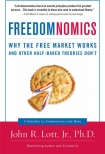Freedomnomics: Why the Free Market Works and Other Half-Baked Theories Don't John Jr. (the dot read aloud .txt) 📖

- Author: John Jr.
Book online «Freedomnomics: Why the Free Market Works and Other Half-Baked Theories Don't John Jr. (the dot read aloud .txt) 📖». Author John Jr.
We find the same kind of incentives at work in baseball. The American League has more hit batsmen than the National League, but this difference only appeared after 1973, when the American League removed its pitchers from the batting lineup in favor of designated hitters. Since American League pitchers no longer worried that they themselves would be hit in retaliation if they threw at an opposing batter, they began throwing more beanballs.2
The reverse of this fundamental principle also holds true: when you make something less costly, people will do more of it. And if you offer a meaningful reward for some type of behavior, you can bet more people will do it, even if they shouldn’t. This is borne out by a study of a specific type of fraud by air traffic controllers.3 To receive disability benefits due to job-related stress, air traffic controllers must present a well-documented stressful incident—a collision or close call—that has caused a deterioration in their performance. Unsurprisingly, when it became easier to file for disability, flights suddenly started experiencing more “close calls.” And these were not cases that the air traffic controllers could simply make up; they were reported by a sophisticated performance evaluation called the “Operation Error Severity Index.”4
Analyzing incentives in this way is a particularly good method for studying crime. It helps reveal what factors increase criminality, and what methods work best to reduce crime rates. Studying incentives also leads us to some surprising conclusions about the effects of abortion, affirmative action, and the death penalty on crime, while showing how certain kinds of high penalties and other policies can inadvertently increase crime rates.
Why did Crime Fall During the 1990s?
“[It] remains one of the great mysteries of our time.”
—Wesley Skogan, a criminologist at Northwestern University, on the long and steady drop in crime during the 1990s.5
Violent crime in the United States shot up like a rocket after 1960. From 1960 to 1991, reported violent crime increased by an incredible 372 percent. The disturbing trend was seen across the country, with robbery rates peaking in 1991 and rape and aggravated assault following in 1992. But then something unexpected happened—between 1991 and 2000, rates of violent crime and property crime fell sharply, dropping by 33 percent and 30 percent, respectively. Murder rates were more stable up to 1991, but then they also plunged by a steep 44 percent.6
Murder and Non-negligent Manslaughter in the United States from 1960 to 2005
Violent Crime Rates other than Murder in the United States from 1960 to 2005
Property Crime Rates in the United States from 1960 to 2005
This drop in crime was particularly surprising because it occurred after some academics had predicted that the advent of “super-predators”—a rising generation of conscienceless violent youth—would soon lead to an explosion of crime.7 Also unexpectedly, the phenomenon was not confined to the U.S.—a remarkably similar pattern was evident in Canada, where violent crime rates peaked in 1992 and property crime and murder rates topped out in 1991. While the declines in violent crime and murder rates during the 1990s were smaller in Canada than in the United States, the fall in Canadian property crimes was slightly larger.8
Homicide Rate in Canada from 1961 to 2005
Violent Crime Rate Other Than Murder in Canada from 1961 to 2005
What’s more, the drop in crime may be even larger than these statistics indicate due to one factor that is often overlooked: rising rates of crime reporting by victims. With the exception of the data on murder, the crime data cited above—supplied by the FBI—are based on crimes that victims reported to police departments. But, of course, not every victim reports when a crime occurs. Victims are most likely to report two kinds of crimes: the most serious crimes and the ones that they believe have the greatest chance of being solved. These trends reinforce each other: victims report the most serious crimes, which in turn receive the most attention from police. This makes serious crimes more likely to be solved and thus even more reporting is likely to occur. Two simple diagrams show how the rate of reporting of violent crimes and property crimes in the U.S. has increased alongside rising arrest rates, suggesting that the increased arrest rates have encouraged more reporting.9
How Did the Rate That Violent Crimes are Reported Vary with the Rate That Violent Crimes Result in Arrest?
How Did the Rate that Property Crimes are Reported Vary with the Rate that Property Crimes Result in Arrest?
Less serious crimes, receiving less police attention, are not as likely to be solved and are also less likely to be reported. During 2005, victims reported only about 20 percent of larcenies to police, compared to an estimated 63 percent of rapes and 68 percent of aggravated assaults. Since more than half of all larcenies involve items worth less than $100, this should come as no surprise.10 Many people are deterred from reporting petty crimes by the inconvenience of dealing with the police and the slim chance of recovering the items.
So why is the rising rate of crime reporting important? Recall the example of the basketball referees: increasing the number of officials discouraged fouls, but it also made any given foul more likely to be noticed. The same effect is at play with the crime rate, which fell sharply in the 1990s even while the rate of reporting violent crime noticeably increased.
This trend indicates that anti-crime efforts in the 1990s were even more effective than is





Comments (0)